Diseases of cucumbers in greenhouses and open ground are numerous and varied. In greenhouse conditions they are much more common and their harmfulness is much higher than in open ground. How to prevent disease and cure already diseased cucumbers is described in detail in this article.
| Contents: Treatment of diseases of cucumbers in open and closed ground
|
Powdery mildew or ash

The disease appears on the leaves of cucumbers.
The disease is very harmful to greenhouse cucumbers, where it spreads instantly. In open ground it is less common and spreads less rapidly.
The causative agent is a pathogenic fungus oidium, it belongs to a different order than the causative agent of powdery mildew on currants and gooseberries. The pathogen overwinters on plant debris. Infestation can occur throughout the season. Primary outbreaks appear near doors and windows, in open ground - in the most moist and shaded places.
The cucumber disease spreads very strongly at high humidity and strong temperature changes in the greenhouse. On the street, the first outbreaks appear 3-4 days after heavy rains.
Another name for the disease is ashtray.
Description of the disease. A white coating appears on the leaves, stems and petioles and spreads quickly. The spots gradually merge and darken, becoming dirty gray or ashy in color. The leaves become wavy, their edges bend downwards and gradually dry out. After a few days, the affected leaf dries out, and the disease spreads to the upper leaves. With strong spread, individual lashes dry out first, and then the entire plant dies.
Greens are not affected by ash grass, but as the disease develops they become smaller and become bitter.The spread of the disease is facilitated by sharp fluctuations between day and night temperatures, as well as prolonged cold weather and dampness.
Treatment of the disease
Treatment of cucumbers in a greenhouse should begin immediately.
- At the first signs of the disease, cucumbers are sprayed with any of the following preparations: Ordan, Quadris, Topaz, Bayleton, Topsin-M, Tilt.
- After 14-20 days, repeat spraying is carried out (the specific period depends on the period of the protective effect of the drug).
- It is better not to use colloidal sulfur and preparations based on it on cucumbers (and other pumpkins). Firstly, they are not used in cold weather (temperatures below 20°C), since the drugs are ineffective under such conditions. Secondly, at the slightest excess of concentration or in sunny weather, severe burns occur on the leaves and vines.
- Use of the biological drug Alirin-B at an early stage of disease development. It is non-toxic, and greens can be harvested 2 days after treatment.
When treating plants, they are never sprayed twice with the same preparation, since the pathogen develops resistance extremely quickly.
Folk remedies for treating illness
- Spraying cucumbers with milk or kefir (1 l/10 l of water). Lactic and lactic acid bacteria are antagonists of pathogenic fungi and suppress their growth and development.
- Iodine treatment. 10 ml of 5% alcohol solution/10 l of water. Carry out double treatment with an interval of 7 days. Both iodine and alcohol are antiseptics and cause the death of pathogens. Effective at the initial stage of the disease.
- A strong solution of potassium permanganate, dark pink in color. Carry out 3-fold processing.
- Treatment with soda ash. 1 tbsp. dilute in 2 liters of water, add soap as an adhesive and process the cucumbers.
Whatever means of control are used, the affected leaves must be torn off and burned.
Prevention
- Cleaning up all plant debris.
- Disinfection of greenhouses before sowing seeds.
- Removing weeds around the perimeter of greenhouses or cucumber beds. The pathogen can persist on them.
- Growing resistant varieties: Boy with Thumb, Geisha, Gostinets, Golubchik, Krokodilchik, Murashka, Octopus.
Cucumber varieties that are completely resistant to powdery mildew have not yet been developed.
Downy mildew or peronosporosis
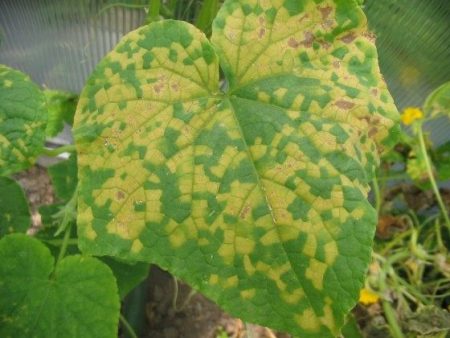
Disease on cucumber leaves in a greenhouse.
The causative agent is the fungus peronospora. Downy mildew differs from the real one in that its mycelium (mycelium) develops on the underside of the leaf, and spots appear on top. The spots themselves, unlike ashtray, are yellow or brown.
The disease most often affects greenhouse cucumbers. Its spread is favored by high humidity and cold nights. It most often appears in late July-early August, but can appear earlier. It is stored in the soil for 6-7 years.
Signs of defeat. The disease appears on the leaves of cucumbers. Numerous irregularly shaped yellow-oil spots appear on the upper side of the leaves. Within 5-7 days, the spots enlarge and turn brown. On the underside, the mycelium is a white-purple coating.
The leaves dry out within 2-3 days. If the disease on cucumbers is not treated, then in a week it can destroy the entire greenhouse.
Methods of treating the disease
- Stop watering and ventilate the greenhouse well.
- Remove all affected leaves.
- Sprinkle the soil under the plants with ash to prevent the spread of the pathogen.
- Treatment with Previkur, Consento, Revus.
- Use of preparations containing copper: Abiga Pik, Ordan. Bordeaux mixture is ineffective in the fight against peronosporosis.
- Spraying with biological products: Trichoderma, Gamair.
Folk methods of struggle
- Spraying with a bright pink solution of potassium permanganate.
- 25 g of soda ash is dissolved in 5 liters of hot water, 5 g of tar soap is added. Cucumbers are sprayed at the initial stage of the disease.
All spraying is carried out on the underside of the leaves.
Prevention
If cucumbers are planted in the same greenhouse from year to year, then fungal spores accumulate there in large quantities.
- In early spring, remove the top layer of soil, replacing it with fresh soil.
- Preventive spraying of cucumbers with biological products Fitosporin and Gamair. The interval between treatments is 5-7 days.
- Growing varieties resistant to downy mildew: Affin, Golubchik, Octopus, Pekti, Ekipazh.
Prevention is a fairly effective method. It reduces the risk of disease development on cucumbers in a greenhouse by 1.5-2 times.
Bacteriosis or angular spot
The causative agent is a bacterium from the genus Pseudomonas. Preserved on plant debris and in seeds. The development of the disease is promoted by high humidity and temperature. It most often affects greenhouse cucumbers. In closed ground, you cannot water the crop with rain, as drops of water on the leaves contribute to the spread of infection.
Description of the disease
The disease affects leaves, fruits and seeds. The disease on cucumbers can appear during the entire growing season, including during the germination phase.
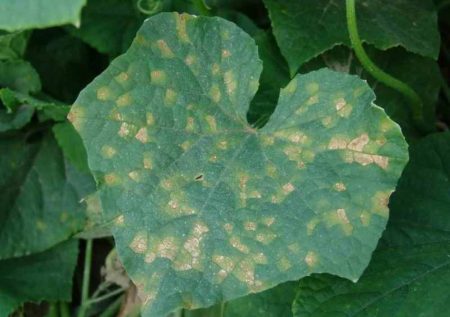
The disease appears on the leaves and then spreads to green plants.
- Yellow angular spots appear on the leaves, which then turn gray-brown and dry out. At this point, the tissue falls out, holes appear on the leaves, and then they dry out.Dull pink droplets of liquid appear on the underside
- Brown ulcers appear on the fruits, which are filled with dirty pink contents. When the liquid dries, a film appears on the surface. In places where spots appear, the fruits become distorted. The infection penetrates into the pulp of the fruit, and from there into the seeds, where it persists until the next season. Greens with angular spotting become inedible. But the disease in dachas, as a rule, does not reach this stage of development.
If cucumbers are not treated, the plants die both in the greenhouse and in the open ground
How to treat bacteriosis
Despite the fact that the causative agent of the disease is of bacterial origin, it is treated with fungicides (antifungal drugs). They are quite effective.
- The most effective against bacteriosis are copper preparations: Kuproxat, Bordeaux mixture, Abiga Peak. The greens should then not be eaten for 20 days.
- Use of the biological product Fitolavin. It belongs to phytoantibiotics (biobactericide) and completely destroys the causative agent of the disease. To prepare a working solution, 2 ml of the drug is diluted in 1 liter of water, the consumption rate is 10 l/100 m2. The solution is used only fresh, it is not stored.
- When feeding, increase the dose of potassium fertilizers or make additional potassium fertilizing.
Effective folk remedies fight against bacteriosis does not exist.
Prevention
- When the first signs of disease appear on cucumbers, watering is reduced and greenhouses are constantly ventilated. Air humidity should be reduced to 80-85%. The air, soil and plants must be dried.
- Collection and destruction of plant residues.
If bacteriosis appears in the greenhouse, it is advisable to replace the soil in the fall.
Anthracnose
The disease usually accompanies bacteriosis.It affects all above-ground parts of the plant: leaves, vines, greens. It appears in the second half of summer; greenhouse cucumbers are particularly affected by anthracnose.
The causative agent is a fungus that survives on plant debris.
Signs of illness. The disease initially affects the leaves. Vague, rounded brown spots appear on them, which then merge. Most of the leaf takes on a burnt appearance. The leaves are drying up and crumble. Orange mucous pads may appear on the vines and stems.
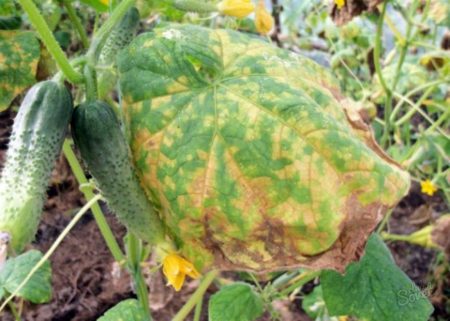
Leaves of cucumbers suffering from anthracnose.
Later, anthracnose affects young greens. Brown sores with hard edges appear on them. They are very similar to bird bites. Affected cucumbers are unsuitable for food.
Treatment of the disease
The fungus attacks cucumbers especially hard in hot and humid summers. In a greenhouse, crops get sick more often than in open ground.
- At the first signs of disease, the affected parts of the cucumbers are removed and burned.
- At an early stage of development, treatment with biological products is quite effective: Alirin B, Fitosporin.
- Spraying cucumbers with copper preparations. It is advisable to do preventive spraying after the appearance of 5-6 leaves. Then the likelihood of cucumbers being affected by anthracnose is noticeably reduced. Copper has a good healing effect, but after processing greens cannot be eaten for 20 days. Simultaneously with spraying, watering is carried out with the same preparations, since the pathogen persists on the soil and lower yellowed and fallen leaves.
Prevention
- Disinfection of greenhouses in autumn. In the greenhouse, a sulfur bomb is set on fire, and 3-5 days after this, the ground is spilled with copper sulfate (1 tablespoon per 10 liters of water), or a dark crimson solution of potassium permanganate.You can sprinkle the ground with bleach, and after a week dig it up with a shovel. But this should only be done in the fall.
- In the spring, you can also set fire to a sulfur bomb. Boiling water is poured onto the ground several times.
- During the growing season, carry out 2-3 preventive sprayings with copper-containing preparations.
- Destroy weeds around the cucumber plot, as they can also be affected by anthracnose.
- Constantly ventilate the greenhouse. It is especially necessary to do this in the early morning, when dew appears on the leaves of the cucumbers.
Anthracnose is easier to prevent than powdery mildew or downy mildew.
White rot
The causative agent is a pathogenic fungus. Greenhouse cucumbers usually get sick. When growing cucumbers in open ground white rot is quite rare. The spread of the disease is facilitated by high air and soil humidity and insufficient ventilation of greenhouses. Watering with cold water and sudden changes in temperature provoke the disease. The fungus is preserved on plant debris.
Signs of defeat. Flakes of a white fluffy coating resembling cotton wool appear on the leaves, petioles, vines and green shoots. Black spots of sporulation later appear on it. The affected areas become soft and slimy. If no action is taken, the plant dies.
How is the disease treated?
- Spraying cucumbers with copper preparations: Ordan, HOM, Bordeaux mixture.
- The lash below the affected area is cut off with pruning shears and burned. The cut is treated with chalk, coal, and ash. All affected green plants are removed.
- At the onset of the disease, treatment of cucumbers with biological products is effective: Gamair, Alirin B, Glyokladin, Planriz.
- Feed the plants with nitrogen fertilizers with the addition of copper sulfate on the tip of a knife.
Traditional methods of treatment
- The plaque is removed manually, and the stem is treated with a light pink solution of potassium permanganate.
- When there is high humidity in the greenhouse and the threat of disease, cucumbers are sprayed with a milk solution. 1 liter of milk per 10 liters of water, add soap to the working solution as an adhesive.
Prevention
- Thorough ventilation of the greenhouse every day. If the nights are warm, then the greenhouse is left open at night.
- Reduce watering. When the disease appears, cucumbers are watered rarely, but abundantly.
- Timely collection and destruction of diseased leaves.
- Every 2 weeks, remove the bottom 2 leaves from the cucumbers. This prevents excessive soil moisture and prevents the occurrence of diseases.
Brown (olive) spot or cladosporiosis
A fungal disease. Most often occurs in greenhouses. The main cause of the disease is sprinkling of cucumbers with cold water, as well as cold weather (10-13°C day and night). The pathogen persists on plant residues and in soil; it tolerates unfavorable winter conditions well. Therefore, when growing cucumbers in greenhouses, when a disease appears, it is necessary to change the soil and disinfect the greenhouse.
Signs of the disease. It most often affects young green plants, less often leaves. Brown and dark brown sores appear on green plants, releasing droplets of cloudy liquid. Gradually, spots cover the entire fruit, and it becomes inedible.
Small dark brown spots appear on the leaves, which gradually merge.
How to treat
- Treatment with copper preparations.
- Ventilation of the greenhouse.
- At the very beginning of the development of the disease, treatment with biological preparations Fitosporin, Pseudobacterin, Gamair.
Prevention
- Do not water cucumbers by sprinkling.
- Water only with warm water.
- Timely harvesting of all affected fruits and leaves.
- It is advisable to perform crop rotation in the greenhouse.
- Growing resistant varieties: Amur, Alphabet, Amazon, Valaamsky, Dobrynya, Green Wave, Pogrebok, Five Stars.
Cladosporiosis on cucumbers is very harmful and difficult to treat. If you do not take measures, you may be left without a harvest.
Gray rot
The disease is caused by pathogenic fungi that live in the soil and on plant debris. Affects stems and fruits. The appearance of the disease on ground cucumbers is facilitated by low night temperatures, watering with cold water, poor ventilation and dense plantings. With strong thickening, the varieties develop a huge amount of barren flowers, the pedicels of which are affected first.
Description of the disease. On the lashes, especially at the branches, in the axils of the leaves, gray slimy spots with a gray smoky coating appear. The spots quickly merge, covering large areas of the stem.
On fruits, the disease begins at the spout (where the flower was). A smoky coating quickly covers the entire fruit, it becomes slimy and falls off.
Control measures
- At the initial stage of the disease, treatment of cucumbers with biological products Gamair, Alirin B, Planriz.
- Treatment with Bayleton.
- Spraying with Euparen before fruiting begins. The drug cannot be used during the fruiting period. The solution should not be mixed with Bordeaux mixture and no adhesives should be added.
- Timely removal of affected plant parts.
Traditional methods of treatment
- Spraying with a mixture of ash (1 cup), chalk (1 cup), copper sulfate (1 tsp), per 10 liters of water. Water the cucumbers with the same solution.
- Spraying with iodine solution. 10 drops of the drug per 10 liters of water. It is used for both prevention and treatment of the initial stage of the disease.
- Treatment with a pink solution of potassium permanganate helps quite well with all types of rot.The treatment is repeated after 4-6 days.
- Spraying cucumbers with tar infusion. Tar soap (20 g) is dissolved in 10 liters of water and treated.
All folk remedies are used mainly for prevention. If the first signs of the disease appear, you need to move on to treatment with biological products.
Preventive measures
- Do not thicken the crops.
- Humidity reduction up to 80%.
- Regular ventilation of the greenhouse.
- Timely removal of lower leaves.
- Collection and destruction of diseased greens.
- Remove barren flowers in a timely manner.
If the rules of agricultural technology are followed, gray rot usually does not appear in greenhouses.
Fusarium
The causative agent is pathogenic fungi. Cucumbers get sick mainly in greenhouses. The pathogen persists for a long time in the soil and on plant debris, as well as in seeds. The disease spreads in cold weather with soil temperatures below 18°C and high humidity.
Signs of defeat. It affects the roots and basal part of the stem. Penetrates into the roots through root hairs and wounds.
The first signs are the withering of individual leaves at the top of the stem, gradually withering goes down, covering the entire stem and neighboring vines. The cucumbers look like they haven't been watered for a long time. A pink coating appears on the stems at the very surface of the soil - sporulation of the fungus.
Along with wilting, the root part of the stem rots. If you dig up the ground, you will find that the bark on the roots and root collar is cracked, and the roots themselves become brown and die. On a cross section of the root collar, browned vessels are clearly visible.
How to treat the disease
- At the very beginning of the disease, when the leaves droop with sufficient watering, biological products help well.Cucumbers are watered with a solution of one of them: Pseudobacterin, Glyocladin, Trichocin, Planriz, Trichoderma. Simultaneously with watering, the root part of the stem is sprayed. The treatment is repeated after 5 days.
- Watering plants at the roots with Previkur.
Once the disease has fully developed, the cucumbers cannot be saved. Diseased plants are removed and the ground is sprinkled with bleach. Neighboring cucumbers are treated for preventive purposes.
Prevention. When fusarium appears in the greenhouse, the soil is completely replaced. If this is not possible, then sprinkle it with bleach, and after 3 weeks, dig it onto the bayonet of a shovel.
It must be remembered that the causative agent of fusarium is very resistant to unfavorable conditions and remains viable for up to 7-9 years.
Since the fungal spores are stored in the seeds, all seeds must be treated before sowing, otherwise cucumbers will have to be treated for this disease again.
Cucumber mosaic virus
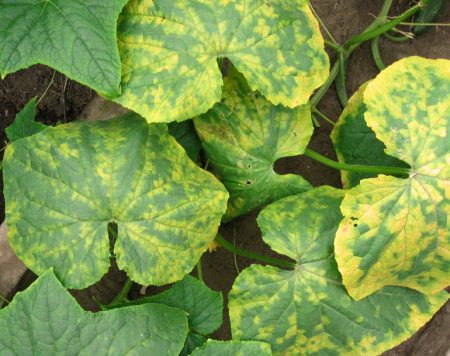
This is what diseased leaves look like with cucumber mosaic.
The causative agents are a group of viruses that cause various manifestations of the disease. In addition to cucumbers, viruses infect tomatoes, sweet and hot peppers, lettuce, beans, cabbage, currants, raspberries and about 700 more cultivated and wild plants. The virus persists on plant debris and in the roots of weeds for several decades.
Viral diseases mainly affect greenhouse cucumbers. In open ground, the disease practically does not occur on crops. The disease is very dangerous; if no action is taken, it can appear on most garden crops, as well as on shrubs.
There are 2 types of pathogens found in summer cottages: green mottle virus and mosaic virus.
Green speckled cucumber mosaic
Crop losses are up to 50%.The virus affects crops growing with cucumbers in the same greenhouse (except eggplants). Cucumbers are affected throughout the growing season, starting from germination.
The virus is spread by seeds. It is also transmitted from diseased plants to healthy ones by contact when caring for cucumbers.
Description of the disease. The disease may not appear on cucumbers for a long time. The first signs appear after a sharp rise in temperature above 30°C. The veins on the leaves take on a yellowish tint. Pale yellow streaks or spots appear along them, which then spread to the entire sheet. Dark green and yellow-silver spots appear. Leaves become deformed and die.
The same spots and streaks appear on the greens. Some strains of the virus cause deformation of fruits. Cucumbers become shortened and bitter; the seeds of the varieties do not develop, but remain in their infancy.
Common cucumber mosaic
The source of infection is contaminated seeds. The virus is actively transmitted by aphids. In winter, it persists on weeds (woodlice, sow thistle, quinoa), as well as on infected currant and raspberry bushes.
Signs of defeat. The earliest signs may appear during the germination period, but usually the first symptoms appear during the growth of the vines. Yellow and dark green spots appear on diseased leaves, the leaf becomes lumpy, corrugated, wrinkled, and its edges bend down. Around the veins the color may turn dark green.
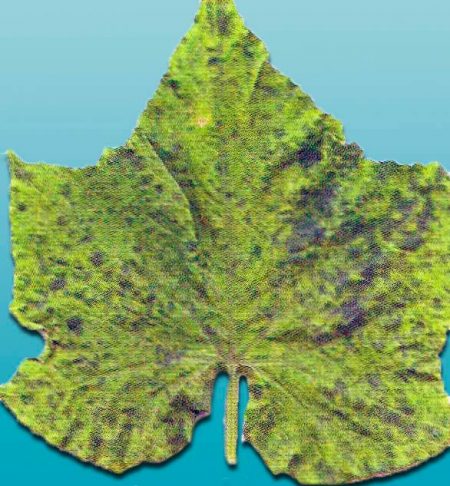
A leaf affected by ordinary mosaic.
The greens become speckled or striped and, if severely damaged, become wrinkled. Dark green areas become convex, and areas with normal or light color become depressed. Fruits are especially severely deformed when the temperature drops to 17-19°C.
On the vines, the internodes are shortened. The growth of lashes stops. If the first signs of the disease appear in the second half of summer, then the cucumbers are not so damaged.
Anti-virus measures
- When the first signs of infection of cucumbers (and other cultivated plants and shrubs) appear, they are treated with the drug Farmayod, which has a strong antiviral effect. The drug is sold in garden stores. You can use its analogue Povidone iodine. After treatment, you should not water the cucumbers on the leaves and allow condensation to form in the greenhouse, since the preparation is easily washed off from the treated surface.
- In case of severe infection, diseased cucumbers are removed and burned, the rest are treated with Farmayod.
Disease prevention
- Mow all weeds around the perimeter of the site.
- It is not recommended to plant other pumpkin crops nearby, as the virus is transmitted through water, soil, and when plants come into contact with each other.
- Destruction of aphids in a summer cottage.
- Growing virus-resistant varieties: Alphabet, Ozornik, Nezhinsky, Merry Friends.
- Complete replacement of soil in the greenhouse.
The cucumber mosaic virus is very dangerous. If after the first treatment of cucumbers the symptoms of the disease continue to increase, then the plant is removed. Sometimes you have to completely destroy all greenhouse cucumbers; here you have to choose between preserving the plants and the very high risk of infecting shrubs and trees.
You might be interested in:
- How to get rid of the most dangerous pests of cucumbers
- What to do if cucumber leaves begin to turn yellow
- Why did the leaves of the cucumbers in the greenhouse suddenly begin to fade?
- How to grow cucumbers in bags
- 5 ways to feed cucumbers
- Why does the ovary of cucumbers turn yellow and how to fix it
- Tomato diseases and methods of treating them
- What causes sweet peppers and how to treat them?
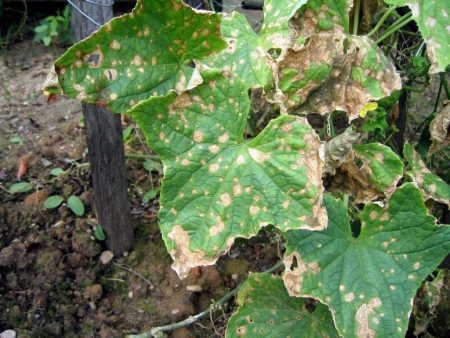
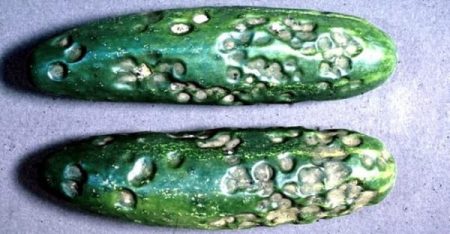
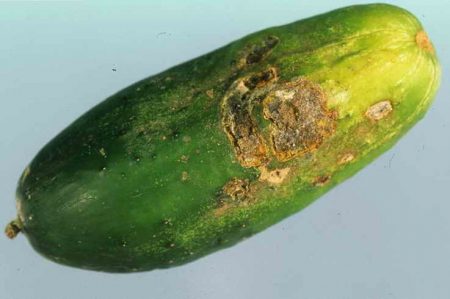
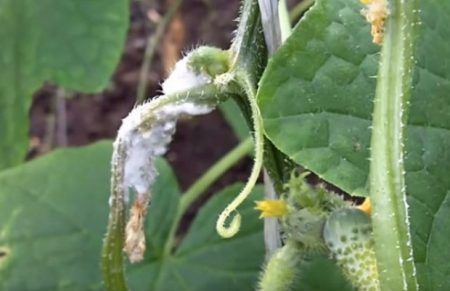
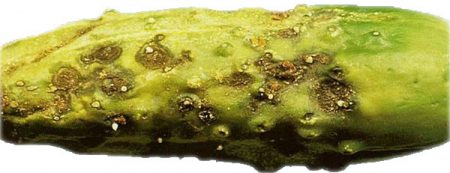
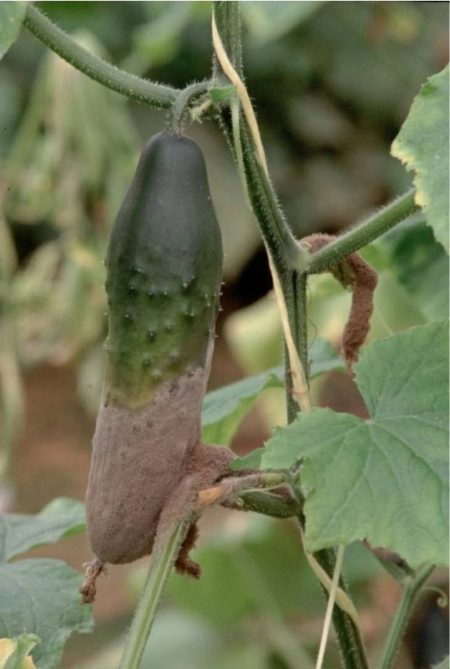
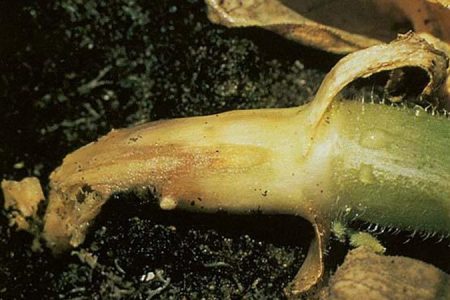

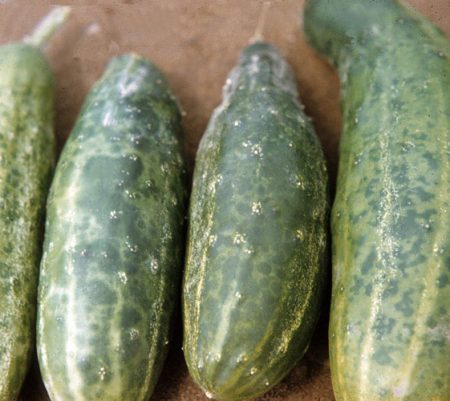

 (7 ratings, average: 4,86 out of 5)
(7 ratings, average: 4,86 out of 5) CUCUMBERS NEVER GET SICK, I'VE BEEN USING ONLY THIS FOR 40 YEARS! I SHARE A SECRET WITH YOU, CUCUMBERS ARE LIKE THE PICTURE!
CUCUMBERS NEVER GET SICK, I'VE BEEN USING ONLY THIS FOR 40 YEARS! I SHARE A SECRET WITH YOU, CUCUMBERS ARE LIKE THE PICTURE! You can dig a bucket of potatoes from each bush. Do you think these are fairy tales? Watch the video
You can dig a bucket of potatoes from each bush. Do you think these are fairy tales? Watch the video
 How our fellow gardeners work in Korea. There is a lot to learn and just fun to watch.
How our fellow gardeners work in Korea. There is a lot to learn and just fun to watch. Eye trainer. The author claims that with daily viewing, vision is restored. They don't charge money for views.
Eye trainer. The author claims that with daily viewing, vision is restored. They don't charge money for views. A 3-ingredient cake recipe in 30 minutes is better than Napoleon. Simple and very tasty.
A 3-ingredient cake recipe in 30 minutes is better than Napoleon. Simple and very tasty. Therapeutic exercises for cervical osteochondrosis. A complete set of exercises.
Therapeutic exercises for cervical osteochondrosis. A complete set of exercises. Which indoor plants match your zodiac sign?
Which indoor plants match your zodiac sign? What about them? Excursion to German dachas.
What about them? Excursion to German dachas.
The following composition helps well against powdery mildew: dissolve 15-20 drops of iodine in 1 liter of natural milk and mix it with 9 liters of water. Spray cucumbers every 10-15 days. I have been using this recipe for a long time and recommend it to others.
Sergey, thank you for sharing your experience. I think this will be interesting to many readers.
Thank you very much very useful information.
I’m very glad, Tatyana, that the article was useful to you.